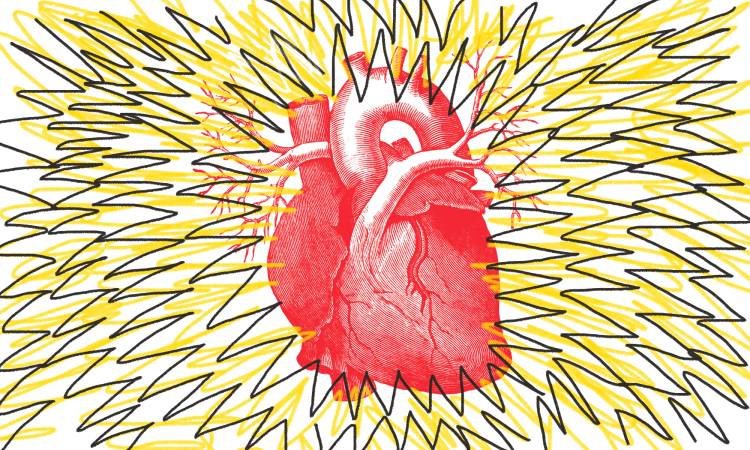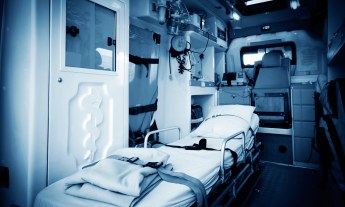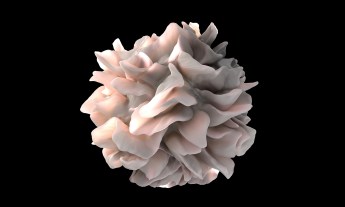
All medical technology carries a price. For implantable defibrillators — which are designed to deliver peace of mind — one of the biggest downsides is fear, says cardiologist Sandeep Jauhar. For patients, the question remains: What are you willing to give up to live a little longer?
In the annals of dying, sudden arrhythmic death is something of a paradox: it is at once the most desirable way to die and the most feared. Sudden fatal arrhythmias are the leading cause of cardiovascular mortality across the world. Millions die from them every year, and most victims, like both my grandfathers, never even make it to the hospital.
Sudden arrhythmic death used to be greeted with almost total helplessness. But things have changed since the implantable defibrillator was invented. In 2016, about 160,000 defibrillators were implanted in the US, more than double from a decade ago. The population of recipients has expanded from survivors of cardiac arrest to patients considered to be at an increased risk of it.
Today the device is tiny (9 defibrillators can fit on a 5 ½-inch-by-8-½-inch page), nearly foolproof, and highly effective. Though it costs approximately $40,000 to implant, considering that defibrillators often extend lives by three years or more, the procedure is a bargain in many cases.
For implantable defibrillators, which are designed to deliver peace of mind, one of the biggest downsides is fear.
But all medical technology carries a different price. Artificial hearts cause blood clots and disabling strokes. Kidney dialysis saves lives but often results in painful, even life-threatening, infections. For implantable defibrillators, which are designed to deliver peace of mind, one of the biggest downsides is fear.
I met Lorraine Flood at NYU Medical Center, where about 20 patients with cardiac defibrillators had assembled for a support-group meeting. She was a tall 71-year-old woman with a regal bearing. Eight years after her first heart attack, she underwent an hour-long operation to implant a defibrillator under her skin. Like most patients, she was told the device would monitor her heartbeat and apply a shock if the rhythm degenerated into something dangerous.
“I was so relieved,” Flood told me. “I used to worry, If something happens, I may not survive it.”
But then her defibrillator started working.
Flood said of the shock from the device: “They never told me it was like a donkey rearing his hind legs and just with all the power he has hitting you right in the chest with full force — bang!”
“I’ve had a horrible time,” she said. “I still wake up every morning and pray to God and say, ‘Lord, please, no shocks today. Please, no shocks today.’”
A few weeks after her implant, she began to have arrhythmias that caused her defibrillator to fire. “I used to see this bluish-white light, and that was my warning I was going to get shocked,” she said. She would sit down and feel the device discharge.
“Nobody told me what it would be like. Oh, they said you’d feel a little something, but they never told me it was like a donkey rearing his hind legs and just with all the power he has hitting you right in the chest with full force — bang!”
Once, she was shocked 16 times in nine days. “I have always had a high threshold for pain — I never take Novocain at the dentist’s — but I just couldn’t handle it.”
Flood’s defibrillator was adjusted to make it less sensitive to arrhythmias, but she continued to feel nervous, increasing the likelihood of future shocks. She quit going to work and hired a full-time driver. She stopped going out with friends and singing in the church choir, and she resigned from the school board. She had tickets to The Lion King but didn’t use them because she was afraid of getting shocked. “Dr. Shapiro said to me, ‘So what if you scream in the middle of the play? You’ll scream, and then you’ll watch the rest of the play.’ But I couldn’t do it.”
Flood developed a Pavlovian fear of places where she had been shocked. One was her shower stall, so she started using the bathtub. “I couldn’t even look at the shower; that’s how frightened I was,” she said. “Then I decided, ‘Lorraine, this is ridiculous.’ One day I opened the shower door and put the water on. But I couldn’t go in. I just watched the water.” Her constant fretfulness put a strain on her family. “I think my husband considered me a little cuckoo,” Flood said.
Of one episode when the device went off, Flood said, “I was screaming, crying uncontrollably, pounding on the door, tearing at my hair.”
A few months after receiving the implant, Flood went to her first support-group meeting. She was surprised at how well people were coping, but she thought some were in denial. “Sometimes I had the impression that people weren’t opening up, that they weren’t 100 percent honest about how painful a shock can be. One lady I befriended got shocked for the first time in a bank. She said, ‘It was nothing.’ Well, it’s not nothing.”
Flood was determined to get on with her life, but her anxiety continued. Pretty soon, she was having full-blown panic attacks, which worsened her arrhythmias. One evening when she was home alone, she experienced an overwhelming fear that her defibrillator was about to go off. She started sweating. She went to her neighbor’s house; in his driveway there was a motion sensor wired to a lamp.
When it went off, so did Flood. “I was screaming, crying uncontrollably, pounding on the door, tearing at my hair,” she said. “I’m the type who needs everything to be in place, and I looked like something the cat dragged in.”
Like many with post-traumatic stress disorder, she started taking Ativan, which helped. But one night, she saw a man in a black suit and a hat standing at the foot of her bed. Hallucinations are an uncommon side effect, but that was it for the Ativan.
Psychologists have come up with two theories to explain PTSD after defibrillator shocks. The first, classical conditioning, refers to the psychological pairing of a previously neutral stimulus (such as taking a shower) with a noxious one (painful shock) so they elicit the same fearful response. In Flood’s case, as well as for other patients at the support-group meeting, fear can heighten arousal and result in even more arrhythmias and more shocks.
The second theory derives from experiments in which dogs were repeatedly subjected to shocks. Compared with controls, animals that are powerless to regulate their shocks become physically exhausted and quickly cease to struggle, despite being given opportunities to avoid the shocks. Researchers concluded that animals acquire a state of “learned helplessness.” Humans who experience frequent shocks develop a similar response.
Researchers have investigated how to mitigate the response of humans to sudden shocks, but nothing has proved more effective than simply reducing the number of shocks people receive.
The key to avoiding a helpless state is to take away the element of surprise. Rats repeatedly shocked without warning develop stomach ulcers. However, rats that can predict when they’ll be shocked because of a warning buzzer develop significantly fewer ulcers. Moreover, rats that can prevent some shocks by pressing a lever develop fewer ulcers than those that receive the same number of shocks but have no control. Ulcers are further reduced when the rats, after pressing the lever, are given a signal that the shock has been successfully prevented. In other words, predictability, control and feedback all reduce shock-induced stress.
Researchers at Wake Forest University have investigated how to mitigate the response of humans to sudden defibrillator shocks. They delivered 150-volt shocks to the arms of volunteers and asked them to rate the pain. Some shocks were delivered alone; others followed a tiny, painless “pre-pulse” so subjects were prepared. The prepulsed shocks were rated less painful than the ones without warning. The analgesic effect was greatest in the subjects who felt the most pain to begin with.
However, nothing has proved more effective than simply reducing the number of shocks patients receive. Reprogramming a defibrillator to make it less sensitive to arrhythmias is the mainstay of treatment. Most patients are also put on an anti-arrhythmic drug, which can have serious side effects (lung and thyroid problems) but which most cardiologists find acceptable if it prevents the occasional errant shock and subsequent psychological cascade.
Patients also often work with a psychologist who specializes in shock-induced anxiety, and many, like Flood, require antianxiety medications or antidepressants. For some, the best treatment is simply refraining from the activities that induce the shocks in the first place.
For now, defibrillators involve a compromise: What are you willing to give up to live a little longer? Ultimately, I think my maternal grandfather died the right way for him; he wasn’t a burden, and he was walking and talking until the very end. He wouldn’t have wanted to live with a donkey in his chest ready to kick at any moment.
In the end, I wondered: Was the defibrillator worth it? “Yes,” Flood said, “because I feel it could give me another six months or a year.”
Not long after our meeting, I went to New Jersey to see how Flood was doing. We sat down in her living room. “I got shocked over there,” she said, pointing to a rocking chair. “I still can’t sit on it.”
Though her fear was not as incapacitating, she said, it was still a daily ritual. She still went “panicville” when a cell phone came near her. (The fear that a cell phone can make a defibrillator go haywire is common but unfounded.) “There are days the defibrillator is constantly on my mind,” she confided. “Sometimes I feel my heart thumping, turning, going topsy-turvy. It frightens me because I’m not sure if it means I’m about to get shocked. At times like these, I forget I’m supposed to be a big girl and overcome it.”
When fear hit, she used simple techniques to divert her thoughts. She sang songs to herself. She chanted a Sanskrit mantra that she has learned as a yoga instructor. And she prayed. Flood started driving again, but she wouldn’t go more than four miles from her house. A driver took her longer distances. And she was back to taking showers every day. “But even now, when I go in the shower, I say to myself, I better face this way in case I get a shock, so I won’t fall out the shower door.”
As hard as she tried, the fear of being shocked still occasionally unnerved her. “If you knew me before, I was such a happy-go-lucky free spirit,” she said. “I’m very reserved now, very cautious. I’m afraid to do things.”
In the end, I wondered, was the defibrillator worth it? “Yes,” she said, “because I feel it could give me another six months or a year.”
Then she paused and added, “Every once in a while, my mind runs rampant, thinking that this is going to be my last day. I say to the Lord, ‘If it’s my time, let me go in my sleep, please.’”
Excerpted with permission from the book Heart: A History by Sandeep Jauhar. Published by Farrar, Straus and Giroux. Copyright © 2018 Sandeep Jauhar.
Sandeep Jauhar is speaking about the impact of emotions on the heart at the 2019TEDSummit in Edinburgh, Scotland. His talk will be posted on TED.com soon.












